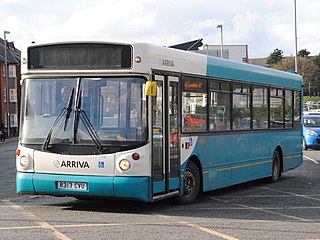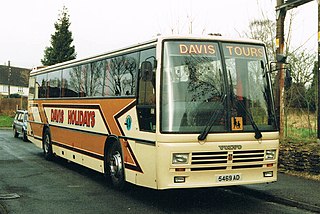
The Scania N113 was a transverse-engined step-entrance and low-floor city bus chassis manufactured by Scania between 1988 and 2000.

The Alexander ALX200 was a single-decker bus body built by Alexander of the United Kingdom. It was created for low-floor bus chassis produced from the late 1990s and was launched in spring 1996 as a low-floor replacement of the Alexander Dash. It was marketed in Alexander's 'ALX' series to fill in the gap between the ALX100 minibus and the ALX300 full-size single-decker.

The Alexander ALX400 was a 2-axle double-decker bus body built by Walter Alexander Coachbuilders. It was one of the ALX-series bodywork, all of which featured the same designs on the front and rear panels that were originally designed for the new generation of mainly low-floor bus chassis produced since the late 1990s.

The Plaxton President was a low floor double-decker bus body built by Plaxton at the former Northern Counties factory in Wigan, England. It was first unveiled in 1997 on the longitudinal Volvo B7L chassis and later built between 1998 and 2005 following a body redesign. When it became part of TransBus International, the body was sold under the TransBus name. The President was built on the Dennis/TransBus Trident, the DAF DB250 and the Volvo B7TL chassis.

Duple Coachbuilders was a coach and bus bodybuilder in England from 1919 until 1989.

Arriva Scotland West was a bus company based in Inchinnan, near Paisley, Scotland. It was formed in 1997 as a rebranding of the former Clydeside 2000 company when purchased by Arriva. On 26 March 2012, the business was sold to McGill's Bus Services.

Southdown PSV Limited, which traded as Southdown Buses, was a medium-sized country bus operator, with 18 routes across East Surrey, West Sussex, South London and Kent, 9 of which were school bus routes. Most of their routes were operated on behalf of Surrey County Council, other work included railway replacement services for planned engineering work.

The Plaxton Elite is a coach body produced by the British bus and coach manufacturer Plaxton. It is primarily targeted at the premium touring market and went into production in late 2008, replacing Plaxton's pre-existing Paragon and Profile coach bodies.

The Plaxton Paramount was a design of coach bodywork built by Plaxton. It first appeared at the 1982 British Motor Show and was built until 1992.

The Plaxton Prestige is a low-floor single-decker bus body built by manufacturers Northern Counties and Plaxton between 1996 and 1999.

The Northern Counties Paladin, also badged as the Plaxton Paladin towards the end of production, is a step-entrance single-decker bus body built by Northern Counties of Wigan, UK, between 1991 and 1998. The replacements for the Paladin are the Prestige and the Pointer as low-floor models for the Paladin LF.

The Northern Counties Palatine was a step-entrance 2-axle and 3-axle double-decker bus body built by Northern Counties from 1988 to 1999 in Wigan, England.

The Wright Endurance was a step-entrance single-decker bus body on Scania N113 and on Volvo B10B chassis by Wrightbus between 1992 and 1997.

A single-decker bus or single-decker is a bus that has a single deck for passengers. Normally the use of the term single-decker refers to a standard two-axled rigid bus, in direct contrast to the use of the term double-decker bus, which is essentially a bus with two passenger decks and a staircase. These types of single-deckers may feature one or more doors, and varying internal combustion engine positions. The majority of single-deckers have a length of up to 12 metres, although some exceptions of longer buses exist. They also typically weigh between 11 and 14 tons.

The Alexander PS-type was a step-floor single-decker bus body built by Walter Alexander Coachbuilders in Falkirk, Scotland and was produced from 1988 to the late 1990s predominantly on the Dennis Lance, Mercedes-Benz O405, Scania N113, Volvo B10M chassis.

The Plaxton Pointer is a single-deck midibus body that was manufactured between 1991 and 2006, predominantly on the Dennis Dart chassis, by Reeve Burgess, Plaxton and latterly Alexander Dennis.

The Alexander Dash is a step-entrance midibus body built by Walter Alexander Coachbuilders of Scotland from 1991 to 1997. Unveiled by Alexander at the 1991 Coach and Bus exhibition in Birmingham, it was one of the variants of Alexander's AM-type body, also using components from the Alexander PS type, and was usually combined with the Dennis Dart and Volvo B6 step-entrance single-decker bus chassis.

The Volvo B10B was a rear-engined step deck single-decker bus chassis manufactured by Volvo between 1992 and 2001. The first prototype were built in 1990, but the B10B wasn't launched until the 1992 Geneva Motor Show. It superseded the Leyland Lynx and Volvo B10R. For stage use it was gradually succeeded by the low-entry B10BLE, which was introduced only a year later, though not in all markets. For interurban use the B7R came as a gradual replacement in 1998, and ultimately for coach work, the B12B took over in 2001.

The Duple 300 Series were a range of bus and coach bodywork built by Duple between 1985 and 1989. The range comprised the 3,000 mm high Duple 300 service bus, the 3,200 mm high Duple 320 coach, and the taller 3,400 mm high Duple 340 coach. The 320 and 340 coaches were announced at the Bus and Coach Show at Earls Court in September 1985 as replacements for the previous Laser and Caribbean. Deliveries of these models commenced in 1986, whilst the 300 bus was launched in 1987 as a replacement for the Dominant Bus. After Duple closed down the designs were sold to Plaxton and a small number of additional 320 bodies were built as the Plaxton 321.





















